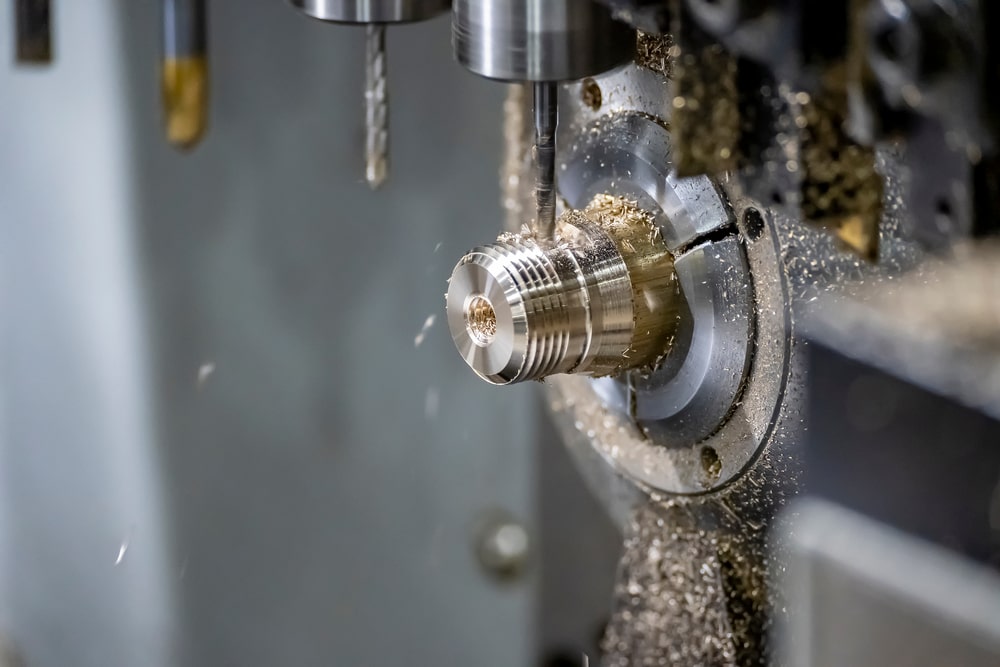

Previously published on fastradius.com on October 5, 2022
In 2021, the global Computer Numerical Control (CNC) machine market size was $56.40 billion. Given how fast, precise, and automated this manufacturing technology is, it’s hardly surprising that the global machine market is expected to grow in the coming years. As the demand for CNC machining grows, the demand for Swiss machining, a manufacturing process that falls under the overall umbrella of CNC machining, will also rise.
As with traditional CNC machining, Swiss machining is used with metal and plastic, offers fast production times, and can produce complex parts with tight tolerances. It’s an incredibly efficient, precise, and repeatable manufacturing process, though it differs in several ways from traditional CNC machining.
In this guide to CNC Swiss machining, we’ll go over what you need to know to decide whether Swiss machining is best for your project.
Originally developed to produce intricate watch parts for the Swiss watchmaking industry in the late 19th century, Swiss screw machines required a skilled operator who could turn handles and push levers to form the desired part. However, thanks to today’s CNC technology, Swiss machining is highly automated and can repeatedly produce complex geometries at tight tolerances with extremely fast cycle times.
As a subset of turning machines, also known as lathes, Swiss machines have stationary tools and a workpiece that can turn and move along the Z-axis, allowing for the creation of round and cylindrical parts. However, its sliding headstock and guide bushing set Swiss machines apart from other turning machines. The sliding headstock feeds the bar stock through a guide bushing, which supports and stabilizes the bar stock near the cutting point. This helps prevent workpiece distortion and enables the machine to accurately create different diameters, complex holes, hex edges, slots, and threads without the need for multiple setups or additional equipment.
When it comes to making parts, Swiss machining is the ideal production method for manufacturing high volumes of small components that require complex turning. Swiss machines are also better suited for machining long parts than traditional CNC turning machines, as they are less likely to cause deflections.
The main difference between traditional CNC turning and Swiss machining is that Swiss machines have a moveable headstock that enables the workpiece to spin and move along the Z-axis, whereas the workpiece remains stationary when using conventional lathes.
Additionally, traditional CNC lathes generally have two, three, or four axes, but Swiss machines often have five, seven, or more axes, enabling operators to quickly machine even the most complex parts. Instead of performing multiple operations or using several setups on numerous machines, manufacturers can often do the job with one Swiss machine and fewer setups. It’s also worth noting that many Swiss machines can perform several tooling operations simultaneously, whereas traditional lathes usually complete one operation before moving on to the next, which can help further accelerate production.
By using a Swiss machine, companies can enjoy a reduction of secondary operations and tool changes, reduced labor costs, and faster turnaround times, all without sacrificing part quality. Since the bar stock is firmly supported, tolerances are tight and complex parts with thin walls or delicate features can be repeatedly manufactured.
Swiss machining was initially used to create the tiny, intricate parts used in watches, and it’s still used to create long, small, or slender turned components across various industries. Its speed, accuracy, and relatively low costs have kept Swiss machining popular.
For example, Swiss machining’s high level of accuracy makes it an ideal manufacturing technology for the defense sector, where small, complex geometries with tight tolerances are often required for military hardware.
Swiss machining also has plenty of applications in the medical industry, where manufacturers can use Swiss machines to produce everything from electrodes to anchors to surgical tools.
In the aerospace industry, Swiss machining can produce components that meet the extreme precision required by the industry’s rigorous demands. The technology can be used to create everything from mechanical components for spacecraft motors to the cockpit controls’ electrical components.
Similarly, Swiss machining’s ability to produce quality and precise parts makes it a popular manufacturing process in the automotive industry. Here, companies use Swiss machines to fabricate bushings, pins, brake system and suspension components, and more.
Essentially, Swiss machining is an excellent production method for manufacturers who need to quickly produce a high volume of small, accurate parts with complex geometries and high-quality finishes for a relatively low cost.
While CNC Swiss machining differs from traditional CNC machining, many best practices should still be kept in mind when designing your part to reduce machining time and costs as much as possible. For example, make sure you remember to:
Swiss machining is a fast, accurate, and cost-effective manufacturing method that’s ideal for creating large quantities of small parts that require complex CNC turning. However, as with any CNC process, it’s best to keep the above tips in mind when designing your parts to ensure your machining time and costs are as low as possible.
Whether Swiss machining is the ideal manufacturing process for your parts or traditional CNC turning is better-suited for your needs, working with an experienced manufacturing partner like SyBridge can help you make the right decisions to get better quality parts faster. Start making the precision-machined parts you need today — contact us to get started.
Forget typical cycle times. We're pushing the boundaries of conformal cooling. While traditional approaches deliver…
Forget typical cycle times. We're pushing the boundaries of conformal cooling. While traditional approaches deliver…
From left to right: Brayden Janak (apprentice); Logan Vifaquain (CNC machining, Programming and CMM); Ron…
SyBridge Technologies is proud to announce we have been awarded the 2023 General Motors Supplier…
Today, designers and engineers are accustomed to working with digital tools in their day-to-day jobs.…
Optimizing Your Injection Molding Process for Cost-Effective Manufacturing Excellence In today’s competitive landscape, manufacturers are…